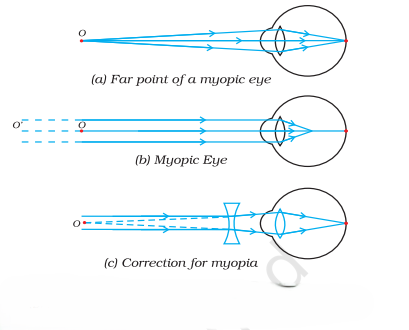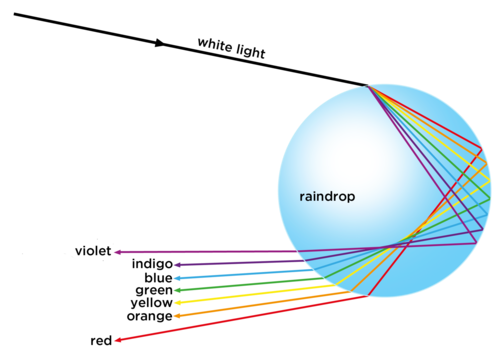Class 10 Science – Chapter 11: The Human Eye and the Colourful World
1. The Human Eye – Structure and Working
The human eye is one of the most sensitive and important
sensory organs. It functions like a camera, helping us to see the world by
receiving light rays, focusing them, and sending signals to the brain.
Major Parts and Their Functions
|
Part |
Function |
|
Cornea |
Transparent outer layer; refracts most of the incoming
light. |
|
Aqueous Humour |
Fluid between cornea and lens; maintains pressure and
provides nutrients. |
|
Iris |
Coloured part; controls size of pupil. |
|
Pupil |
Allows light to enter; black spot in the center. |
|
Ciliary Muscles |
Change curvature of lens for focusing. |
|
Eye Lens |
Convex lens focusing light on the retina. |
|
Vitreous Humour |
Gel-like substance maintaining eye shape. |
|
Retina |
Light-sensitive screen with rods and cones. |
|
Optic Nerve |
Carries signals to brain. |
|
Blind Spot |
No image formation as no receptors. |
|
Fovea |
Sharpest vision area with dense cones. |
2. Accommodation of Eye
The ability of the eye lens to change its focal length to
see distant and nearby objects clearly is called power of accommodation. Ciliary muscles
adjust the curvature of the lens.
Important Points:
|
Feature |
Value |
|
Near Point |
25 cm (normal eye) |
|
Far Point |
Infinity |
|
Power of accommodation |
Eye adjusts focal length between ∞ and 25 cm |
3. Defects of Vision and Their Correction
Myopia (Short-sightedness)
• Can see nearby objects clearly, but distant objects appear
blurry.
• Caused by eye-ball being too long or lens being too convex.
• Image is formed in front of the retina.
• Corrected using a concave lens.
Hypermetropia (Long-sightedness)
• Can see distant objects clearly, but nearby objects appear
blurry.
• Caused by eye-ball being too short or lens less convex.
• Image is formed behind the retina.
• Corrected using a convex lens.
Presbyopia
• Old-age defect where near and distant vision both become
difficult.
• Caused due to loss of flexibility in lens and weakening of ciliary muscles.
• Corrected using bifocal or progressive lenses.
4. Refraction of Light Through a Prism
When white light passes through a glass prism, it splits
into 7 colors – VIBGYOR. This is called dispersion of light. Different colors
refract differently due to varying wavelengths.
5. Atmospheric Refraction Phenomena
Twinkling of Stars
Light from stars undergoes continuous refraction while
passing through various layers of Earth's atmosphere. Due to changing
densities, the apparent position of the star shifts, making it appear to
twinkle.
Advanced Sunrise and Delayed Sunset
Due to atmospheric refraction, we see the Sun about 2
minutes before it actually rises and 2 minutes after it has actually set. The
light bends, making the Sun visible even when it is below the horizon.
Why the Sky Appears Blue
Shorter wavelengths (blue light) are scattered more than
longer wavelengths (red light) by the atmospheric particles. Hence, the sky
appears blue.
Why the Sun Appears Red at Sunrise and Sunset
During sunrise and sunset, sunlight travels a longer path
through the atmosphere. Shorter wavelengths scatter out, and mostly red light
reaches our eyes, making the Sun appear red.
6. Rainbow Formation
A rainbow is formed due to the dispersion, internal
reflection, and refraction of sunlight inside raindrops. It appears as a
spectrum of seven colours in the sky opposite to the Sun after rainfall.
Steps involved:
1. Refraction – Light enters the raindrop and bends.
2. Dispersion – It splits into seven colours (VIBGYOR).
3. Internal Reflection – Light reflects inside the drop.
4. Refraction Again – Light exits and reaches our eyes.
7. Scattering of Light
Scattering is the process of light getting deflected in many
directions by small particles. Rayleigh scattering explains that shorter
wavelengths (like blue) scatter more than longer ones (like red).
8. Important Facts and Values (for Revision)
|
Topic |
Value |
|
Minimum distance of clear vision (normal eye) |
25 cm |
|
Maximum distance of clear vision |
Infinity |
|
No. of colours in visible spectrum |
7 |
|
Cause of rainbow |
Dispersion + Total internal reflection |
|
Red light |
Least scattered |
|
Violet light |
Most scattered |
|
Old age eye defect |
Presbyopia |
|
Defect for blurry near vision |
Hypermetropia |
|
Correction for Myopia |
Concave lens |









0 Comments